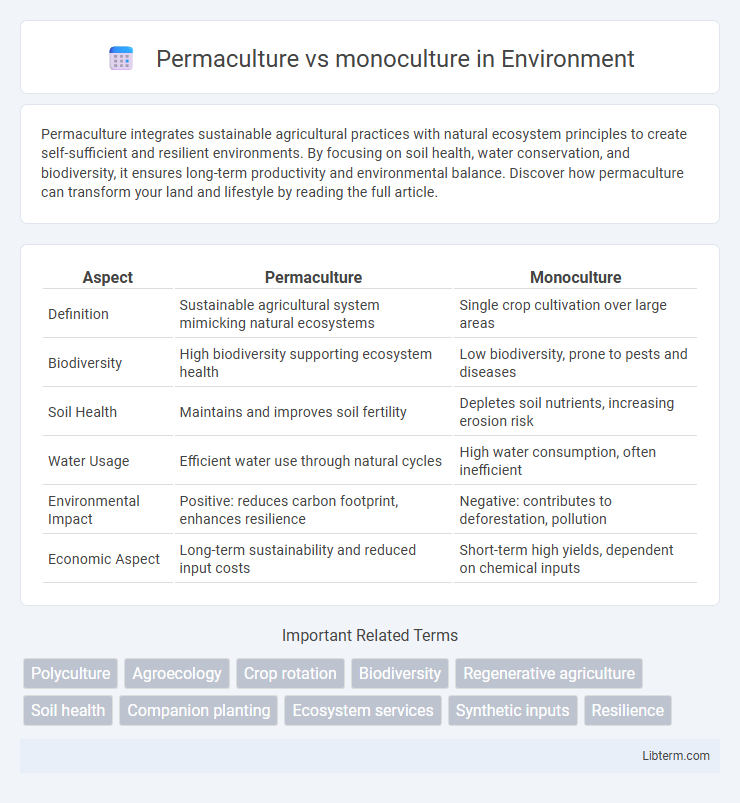Permaculture integrates sustainable agricultural practices with natural ecosystem principles to create self-sufficient and resilient environments. By focusing on soil health, water conservation, and biodiversity, it ensures long-term productivity and environmental balance. Discover how permaculture can transform your land and lifestyle by reading the full article.
Table of Comparison
| Aspect | Permaculture | Monoculture |
|---|---|---|
| Definition | Sustainable agricultural system mimicking natural ecosystems | Single crop cultivation over large areas |
| Biodiversity | High biodiversity supporting ecosystem health | Low biodiversity, prone to pests and diseases |
| Soil Health | Maintains and improves soil fertility | Depletes soil nutrients, increasing erosion risk |
| Water Usage | Efficient water use through natural cycles | High water consumption, often inefficient |
| Environmental Impact | Positive: reduces carbon footprint, enhances resilience | Negative: contributes to deforestation, pollution |
| Economic Aspect | Long-term sustainability and reduced input costs | Short-term high yields, dependent on chemical inputs |
Introduction to Permaculture and Monoculture
Permaculture is an agricultural design system that emphasizes biodiversity, sustainability, and natural ecosystem patterns to create resilient and self-sufficient environments. In contrast, monoculture involves the cultivation of a single crop species over a large area, often leading to soil depletion and increased vulnerability to pests and diseases. Permaculture integrates principles like companion planting, water conservation, and soil regeneration to promote ecological balance and long-term productivity.
Core Principles of Permaculture
Permaculture emphasizes diverse, sustainable ecosystems that mimic natural processes, promoting soil health, water conservation, and biodiversity, contrasting sharply with monoculture's single-crop focus that often leads to soil depletion and increased vulnerability to pests. Core principles of permaculture include observing and interacting with natural patterns, valuing renewable resources, and integrating rather than segregating elements to create resilient agricultural systems. These strategies enhance productivity and environmental stability, making permaculture a holistic approach to land management compared to the resource-intensive, high-risk nature of monoculture farming.
Fundamentals of Monoculture Farming
Monoculture farming involves cultivating a single crop species over a large area, emphasizing uniformity and specialization to maximize short-term yields. This method often relies heavily on synthetic fertilizers and pesticides to maintain soil fertility and control pests, leading to reduced biodiversity and increased vulnerability to diseases. Soil degradation and nutrient depletion are common challenges associated with monoculture, as continuous planting of one crop limits natural nutrient cycling and soil health.
Environmental Impact Comparison
Permaculture promotes biodiversity by mimicking natural ecosystems, enhancing soil health, and reducing the need for chemical inputs, which leads to lower carbon emissions and improved water retention. In contrast, monoculture depletes soil nutrients, increases vulnerability to pests, and relies heavily on synthetic fertilizers and pesticides, contributing to soil erosion, water pollution, and higher greenhouse gas emissions. Sustainable permaculture practices support ecosystem resilience and long-term productivity, while monoculture often results in environmental degradation and loss of biodiversity.
Biodiversity: Permaculture vs Monoculture
Permaculture enhances biodiversity by integrating diverse plant species, promoting a balanced ecosystem with natural pest control and improved soil health. In contrast, monoculture relies on a single crop species, which reduces habitat variety and increases vulnerability to pests and diseases. This lack of biodiversity in monoculture systems often leads to soil degradation and decreased long-term agricultural sustainability.
Soil Health and Sustainability
Permaculture enhances soil health by promoting biodiversity, improving nutrient cycling, and increasing organic matter through diverse plant species and natural ecosystems. Monoculture practices often degrade soil quality due to repetitive planting of a single crop, leading to nutrient depletion, erosion, and increased vulnerability to pests. Sustainable agriculture benefits from permaculture's resilience and reduced chemical inputs, fostering long-term soil fertility and environmental balance.
Resource Efficiency and Inputs
Permaculture maximizes resource efficiency by integrating diverse plant species and natural ecosystems, enhancing soil health and reducing the need for synthetic inputs like fertilizers and pesticides. Monoculture relies heavily on chemical fertilizers and pesticides, increasing input costs and causing soil degradation over time. The sustainable design of permaculture supports long-term productivity with minimal external resources compared to the high input demands of monoculture farming.
Economic Viability and Yields
Permaculture systems often achieve sustainable economic viability by diversifying crops, reducing input costs, and enhancing soil health, leading to stable, long-term yields. Monoculture typically provides higher short-term yields and quicker returns due to scale efficiencies and mechanization but faces risks like soil degradation and market volatility. Long-term profitability in permaculture is favored as it mitigates risks and fosters ecosystem resilience, while monoculture may incur increased costs over time from pest management and soil restoration.
Social and Community Implications
Permaculture fosters stronger community bonds through collaborative land management practices that emphasize local food sovereignty and resource sharing, promoting social resilience and sustainable livelihoods. Monoculture often leads to social fragmentation by prioritizing large-scale, industrial agriculture that can displace small farmers and reduce local food diversity. Community-driven permaculture projects enhance social cohesion by integrating ecological stewardship with cultural traditions, benefiting both environmental and social well-being.
Future Prospects: Toward Sustainable Agriculture
Permaculture offers promising future prospects for sustainable agriculture by promoting biodiversity, soil health, and resilience through diverse plant systems and natural resource cycles. In contrast, monoculture's reliance on single crops increases vulnerability to pests, diseases, and soil degradation, posing risks to long-term productivity. Embracing permaculture principles can lead to regenerative farming practices that support ecosystem balance and food security amid climate change challenges.
Permaculture Infographic

 libterm.com
libterm.com